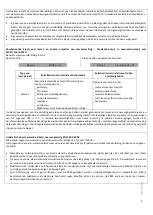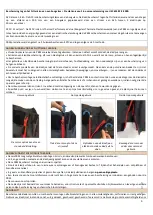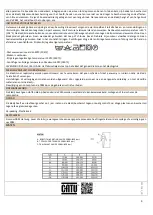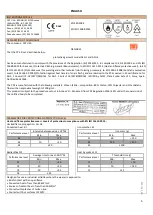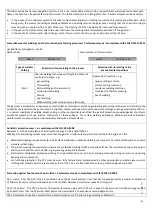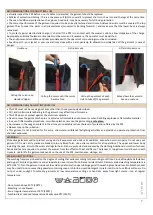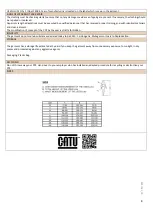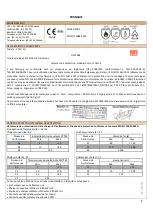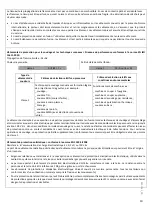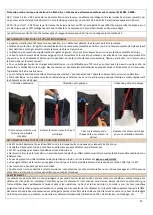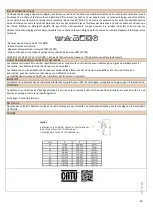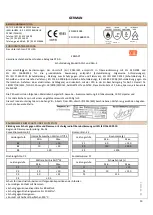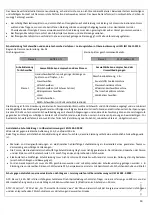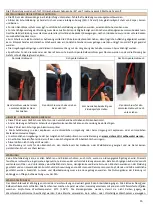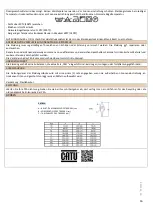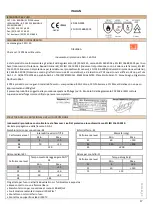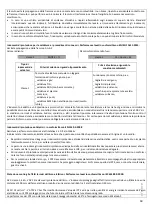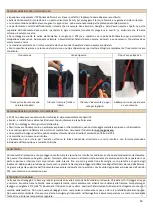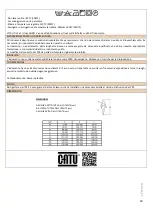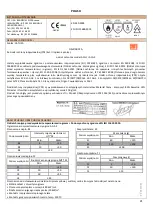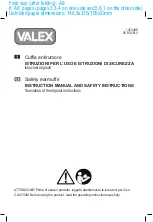
6
9911
34
5_
0
0
The fabric avoids the flame propagation and this is not a non-combustible material. On a repeated brief and accidental contact with
flames, the fabric can be perforated and this normal. The fabric transforms into frangible carbon. A waste disposal can be necessary.
•
In the event of an accidental splash of chemical or flammable liquids on clothing covered by this International Standard while
being worn, the wearer should immediately withdraw and carefully remove the garments, ensuring that the chemical or liquid
does not come in contact with any part of the skin. The clothing shall then be cleaned or removed from service.
•
In the event of a molten metal splash the user shall leave the working place immediately and take off the garment.
•
In the event of a molten metal splash, the garment, if worn next to the skin, may not eliminate all risks of burn.
Protective wear for welding and other technical joint forming processes > Performance levels in compliance with EN ISO 11611:2015
:
Limited flame propagation: A1+A2
Radiant heat:
class 1
RHTI24
7s
Small splashes of molten metal:
class 1
15
Drips < 25
The garment is adapted for an exposure to small splashes of molten metal during soldering and joining techniques and minimize the
possibility of electrical shock by short-term, accidental contact with live electrical conductors at voltages up to approximately 100 V d.
c. in normal conditions of welding. Sweat, soiling, or other contaminants can affect the level of protection provided against short-term
accidental contact with live electric conductors at these voltages. For certain welding operations, additional partial protection
(reinforcement or accessory) can be mandatory and will be at least class 1.
Type of welders
clothing
Selection criteria relating to the process
Selection criteria relating to the
environmental conditions
Class 1
Manual welding techniques with light formation of
spatters and drops, e.g.:
Operation of machines, e.g;
_ gas welding;
_ oxyge cutting machines;
_ TIG welding;
_ plasma cutting machines;
_ MIG welding (with low current);
_ resistance welding machines;
_ micro plasma welding;
_ machines for thermal spraying;
_ brazing;
_ bench welding;
_ spot welding;
_ MMA welding (with rutile-covered electrode);
Antistatic protective wear > in compliance with EN 1149-5:2008
Resistance : to the accumulation of electrostatic cha
rge S ≥ 0,2 and/or t50≤ 4s
Wearing this anti-static garment must avoid that the garment itself causes sparks that could be at the origin of a fire.
•
Material and design requirements for electrostatic dissipative protective clothing, used as part of a total earthed system, to avoid
incendiary discharges.
•
The person wearing the electrostatic dissipative protective clothing shall be properly earthed. The resistance between the person
and the earth shall be less than 108, e.g. by wearing adequate footwear.
•
Electrostatic dissipative protective clothing shall permanently cover all non-complying materials during normal use (including
bending and movements).
•
For full-body protection, the PPE must be worn fully fastened and accompanied by other appropriate protective gear such as
clothing that protects from the same risks as that of the PPE, as helmet with face-screen, protective gloves and boots.
Protection against heat hazard of an arc flash > Performance levels in compliance with IEC 61482-2:2009:
APC : class 1, 4 kA. The APC is the arc protection class. The garment protects from heat hazard experienced by a wearer at a distance
of 300 mm from an arc flash produced by a current of 4kA between 2 electrodes spaced 30 mm apart
ATPV : 12 cal/cm² - The ATPV is the Arc Thermal Performance Value of the PPE and is equal to the amount of incident energy emitted
by an electric arc that the PPE will protect before the user will start to experience second degree burns.
PPE performances have been tested after 5 domestic washes at 40°C and drying according to Method F.


